HIMSS is an annual meeting of the tribe. We have matured as a community. There is a vast ecosystem of small, medium and large vendors. There is a broad Federal presence. There is a vibrant mix of start ups and long established players. There are many success stories from healthcare providers and also troubled implementations to learn from. This is a year of next steps.
It was a week of lively interaction, with 41,000+ of us in Las Vegas. There were over 200,000 tweets. What happened there was broadcast live across many channels. The continued growth of social media may have been the biggest news. #HIMSS16. The connections with peers that once required a live meeting now happen in virtual space every day.
Plenty of technology
It's time to declare victory on the technology side and move on to building the new world where clinical information is ubiquitous, available when and where needed, for an individual, for a population, for research, for managing processes, for continuous improvement, for a learning health system.Swimming in the water, we may not have noticed the transition from the fresh water of the river to the salt water of the ocean. While it is both blue (open to possibilities) and red (full of the blood of battling interests), the more important point is that it is an ocean, very different from the rivers that feed it.
 |
| ONC Report to Congress, February 2016, Possession of certified EHR among office-based physicians and hospitals |
We are in a new world, created from decades of pilots, early adopters, mainstream adopters, overlapping technologies, the explosion of consumer technology, the investment of HITECH, the continued achievement of Moore's Law.
The rate limiting factors are our imagination, our creativity in adapting to the new capabilities, our willingness to progress in times of uncertainty - to manage change, to act and not wait for the next version (there will always be a next, newer, better version), our willingness to actively engage partners, our willingness to fully participate in new payment models.
Alignment across HHS, between ONC and CMS, and with the rest of us
The opening keynote was from HHS Secretary Burwell, with the value of EHRs in surfacing the drinking water issues in Flint Michigan. Flint is both an example of the success of health IT (that the records were available and searchable), and the potential to do so much more (real time public health surveillance).
The conversation between Karen DeSalvo, the National Coordinator for Health IT (ONC), and Andy Slavitt, Acting Administrator for the Centers for Medicare & Medicaid Services (CMS), set the tone for where we are and what's to come: health IT is an enabler for healthcare reform.
This year's discussion continues the collaboration from HIMSS15.
The conversation between Karen DeSalvo, the National Coordinator for Health IT (ONC), and Andy Slavitt, Acting Administrator for the Centers for Medicare & Medicaid Services (CMS), set the tone for where we are and what's to come: health IT is an enabler for healthcare reform.
This year's discussion continues the collaboration from HIMSS15.
Infrastructure
- Increased use of consistent standards across HHS initiatives
- Certified Health IT as a base requirement for participation in HHS initiatives
Interoperability
- No one wants to be labeled a data blocker. After a year of heightened visibility, EHRs vendors have embraced various collaboratives to improve the exchange of information. Moving from press releases to working information exchange is going to take time and continued attention.
- An additional round of HITECH funding is now available to State Medicaid programs to better connect non-Meaningful Use providers (post-acute and long-term care, behavioral health, pharmacies, support services, etc) with Meaningful Use providers (Eligible Hospitals and Eligible Professionals).
App Challenge
- FHIR continues to get attention as the standard API of choice.
- ONC is building on this with two competitions and a new grant opportunity

